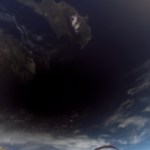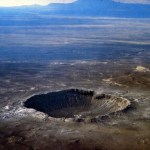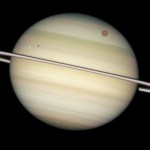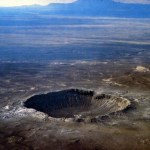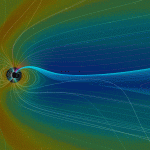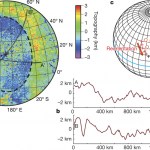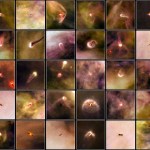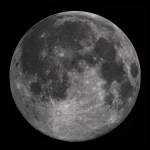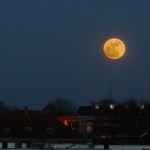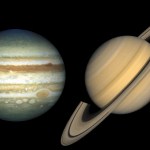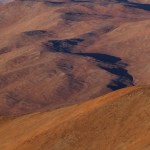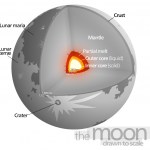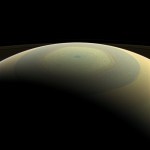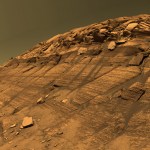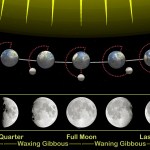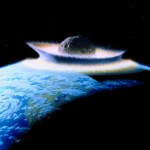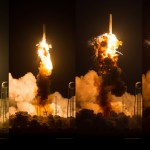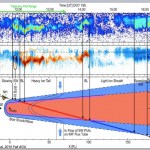Solar System
"To morrow, I believe, is to be an eclipse of the sun, and I think it perfectly meet and proper that the sun in the heavens, and the glory of the Republic should both go into obscurity and darkness together." -Benjamin F. Wade
The Moon is spherical, and so its shadow should be a circle by simple geometry, right? Only, if we view it when it strikes Earth, it’s not even close to a circle. It’s stretched into an ellipse, and further complicated by irregular, sharp edges and corners. Why would it appear that way? As it turns out, three factors combine to get us there.
An illustration of the Sun-…
"By preventing dangerous asteroid strikes, we can save millions of people, or even our entire species. And, as human beings, we can take responsibility for preserving this amazing evolutionary experiment of which we and all life on Earth are a part." -Rusty Schweickart
Asteroid strikes are among the most destructive natural disasters to ever impact planet Earth. While an extinction-level event, like the one that wiped out the dinosaurs some 65 million years ago, are exceedingly rare, we face city-killer impacts somewhere on Earth's surface every few hundred years.
Meteor (Barringer) crater,…
“The dance between darkness and light will always remain — the stars and the moon will always need the darkness to be seen, the darkness will just not be worth having without the moon and the stars.” -C. JoyBell C.
What do you do when you discover a moon around Saturn that's only visible during half of its orbit? If you're Giovanni Cassini, you postulate that half of the moon is darker than the other, and you work tirelessly to improve the telescope so that you can see it when it's in "faint mode." After more than 3 decades, he succeeded.
The ringed planet, Saturn, contains a number of…
"Men of genius are often dull and inert in society; as the blazing meteor, when it descends to earth, is only a stone." -Henry W. Longfellow
When you look at the meteors striking Earth today, as well as over the past 466 million years, you find something surprising: they don’t line up with the population of near-Earth asteroids we find in our Solar System today. In fact, more than 80% of the meteorites we find on Earth’s surface are entirely of the wrong class.
An H-Chondrite from Northern Chile shows chondrules and metal grains. This meteorite is high in iron, and is the most common type…
"Bringing an asteroid back to Earth? What's that have to do with space exploration? If we were moving outward from there, and an asteroid is a good stopping point, then fine. But now it's turned into a whole planetary defense exercise at the cost of our outward exploration." -Buzz Aldrin
Between recent statements from NASA, the American Geophysical Union and Los Alamos National Laboratory, you might think that humanity is overdue for a catastrophic impact from outer space. Indeed, it’s been a long time since we’ve had one that was very destructive, and other than the 1908 Tunguska blast, we…
"We are inside this plasma,
and plasma is inside everything. It is incandescent
in the sun, and I am curious to know if you
are able to stop orbiting yourself around it even for a second." -Marieta Maglas
The phenomenon of solar flares has been understood qualitatively but not quantitatively for a long time. The Sun's magnetic field confines its plasma into thin sheets of electric current, and when the field changes, the lines split and reconnect, causing the plasma to be expelled at tremendous rates. This same physics underlies solar flares, Earth's aurora, laboratory plasmas and possibly…
Just as a Chihuahua is still a dog, these ice dwarfs are still planetary bodies. The misfit becomes the average. The Pluto-like objects are more typical in our solar system than the nearby planets we first knew.” -Alan Stern
The Pluto story just gets better and better. Although the flyby of July 2015 lasted only a few hours, the full suite of data taken took 16 months to transmit back to Earth. That finally completed a few weeks ago, and we not only have a complete high-resolution map of Pluto's surface, we also have topological, chemical/molecular and gravitational data covering the surface…
"The new ALMA images show the disk in unprecedented detail, revealing a series of concentric dusty bright rings and dark gaps, including intriguing features that suggest a planet with an Earth-like orbit is forming there." -Sean Andrews
It takes a lot of work to make a solar system from the raw materials of an interstellar molecular cloud, but the Universe is up to the challenge. We had a theoretical picture that held for a long time, but thanks to the array of modern telescopes that humanity has constructed, we've finally been able to put that picture to the test.
30 protoplanetary disks,…
"From out there on the moon, international politics look so petty. You want to grab a politician by the scruff of the neck and drag him a quarter of a million miles out and say, 'Look at that, you son of a bitch.'" -Edgar Mitchell, Apollo astronaut
The full Moon of November 14th may be special for being the closest, brightest full Moon in over 60 years, but every full Moon is full of delightful sights. There’s science behind it, too; much of what you can see even with the naked eye is evidence of our nearest neighboring world’s unique geological history.
The maria -- or seas -- of the Moon's…
"For most people, we often marvel at the beauty of a sunrise or the magnificence of a full moon, but it is impossible to fathom the magnitude of the universe that surrounds us." -Richard H. Baker
This coming Monday, November 14th, 2016, a full Moon will occur extremely close -- within 90 minutes -- of a very, very close lunar perigee. The Moon will come within 356,509 km of Earth while 99.9% full, making this the most “super” Supermoon Earth has seen in 68 years. No matter where you are on Earth, if you have clear skies, it’s worth a look, particularly right before dawn, where it’s at…
"To raise new questions, new possibilities, to regard old problems from a new angle, requires creative imagination and marks real advance in science." -Albert Einstein
When we first began looking for exoplanets, we were expecting that other solar systems would be like ours: with inner, small, rocky worlds and outer, large gas giants. What we found surprised us in a couple of ways. Not only could planets of any size appear anywhere, as they seem to, but the most common mass for a planet was somewhere between two and ten Earth masses, something we don’t have a single example of in our Solar…
"This is the plan. Get your ass to Mars, and go to the Hilton Hotel and flash the fake Brubaker I.D. at the front desk, that's all there is to it." -Hauser, Total Recall
There are many locations on Earth that look like they’d be right at home on another world. While from space, it’s incredibly evidence how different Mars and Earth are when you view the entire world, there are places on Earth that are virtually indistinguishable from our red neighbor.
Do these rocky outcroppings over an eroded, sandy valley occur on Earth or on Mars?
I’ve compiled 10 images that look like they could be…
"The pressure to compete, the fear somebody else will make the splash first, creates a frenzied environment in which a blizzard of information is presented and serious questions may not be raised." -Carl Bernstein
Why is our Moon so unlike every other moon in the Solar System? No other moon is such a large percent of its parent planet’s mass or size; no other moon rotates so far afield of its planet’s rotational axis; no other moon orbits so far out of the planet-Sun plane. Yet our Moon does it all. The giant impact hypothesis might explain why the Moon is made of the same material as Earth,…
“Cassini is different -- it's a mission of enormous scope and is being conducted in grand style. It is much more sophisticated than Voyager, ... I can't say it's got that flavor of romance, though. Voyager was very romantic. Cassini is spectacular.” -Carolyn Porco
It was a big enough mystery when Saturn’s hexagon was first discovered by going back to archival Voyager data, and then confirmed by Cassini. Over the past 36 years, Saturn’s hexagon has not only persisted, it’s remained completely unchanged in size, extent and speed over that time. An artifact of fluid dynamics and the wind speeds…
"If you look at the field of robotics today, you can say robots have been in the deepest oceans, they've been to Mars, you know? They've been all these places, but they're just now starting to come into your living room. Your living room is the final frontier for robots." -Cynthia Breazeal
Ever since we first began observing Mars up close, there was well-founded speculation that there was a watery past. What appeared to be water-ice features and water-based clouds were abundant, and indirect clues like sedimentary rock, dried-up riverbeds and deposits that appeared to have a watery origin…
"The supermoon is a 16-inch pizza compared with a 15-inch pizza. It's a slightly bigger moon; I ain't using the adjective 'supermoon.'" -Neil deGrasse Tyson
Earlier this month, the full Moon was the first "Supermoon" we've seen all year, where the bright full Moon coincided nearly perfectly with perigee, or the Moon's closest approach to Earth. Yet it won't be the last: November's and December's full Moons will also be Supermoons, appearing up to 14% bigger and 30% brighter than the full Moons from, say, March and April of this year.
A perigee full Moon compared with an apogee full Moon,…
“Honestly, if you’re given the choice between Armageddon or tea, you don’t say ‘what kind of tea?” -Neil Gaiman
Between the near-Earth asteroids that orbit close by our planet, and the distant comets that plunge periodically into the inner Solar System, Earth has plenty to be concerned about over the long haul. A slight gravitational nudge to any of those objects could put them on a collision course for our world. Thankfully, we can see them and track them, and calculate exactly how big of a threat they are to us.
Comet Lovejoy, as seen from the International Space Station, poses no threat…
"There will be peace when the people of the world, want it so badly, that their governments will have no choice but to give it to them. I just wish you could all see the Earth the way that I see it. Because when you really look at it, it's just one world." -Superman
So, you want to shoot Earth’s garbage into the Sun, do you? From a physics point-of-view, this is difficult, but possible. First, you have to overcome the pull of Earth’s gravity, and escape into space. Next, you have to take into account the fact that Earth orbits the Sun at 30 km/s, and to fall into the Sun, you need to take…
“When you arise in the morning, think of what a precious privilege it is to be alive — to breathe, to think, to enjoy, to love.” –Marcus Aurelius
How old is life on Earth? If all you had to go on was the fossil record, you’d run into severe trouble once you went back more than one or two billion years, as all your rock would have metamorphosed, making examination and identification of fossils impossible. But recently, we’ve discovered another method: to measure the isotopic content of carbon deposits in ancient rock formations.
Hadean diamonds embedded in zircon/quartz, some of which…
“Maybe some people don't feel scared when they think about comets and supernovas. Maybe they think it is wonderful.” -Lydia Netzer
What, in our Solar System, has a long tail from boiled-off frozen ices? What simultaneously leaves an X-ray signature when the solar wind collides with those boiled-off atoms, kicking electrons out and causing X-ray emissions? If you guessed a comet, you'd be "traditionally" correct, beginning with Comet Hyakutake in 1996.
Amateur photo of Comet Hyakutake, taken in March of 1996 by John Pane. Image credit: John Pane of http://www.cs.cmu.edu/~pane/hyakutake.html…
